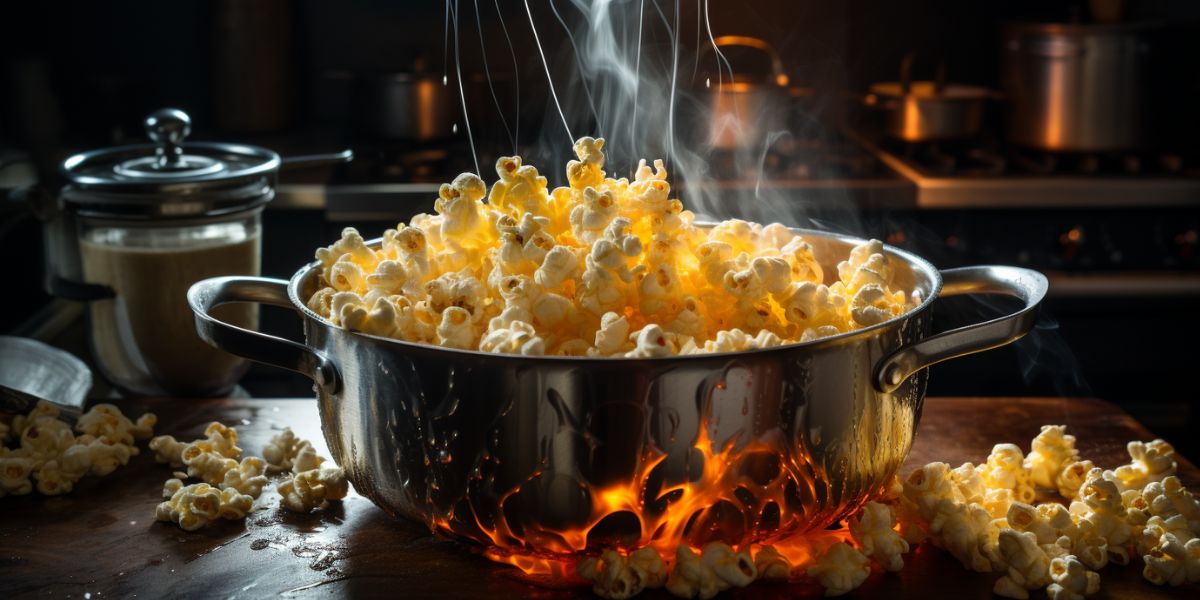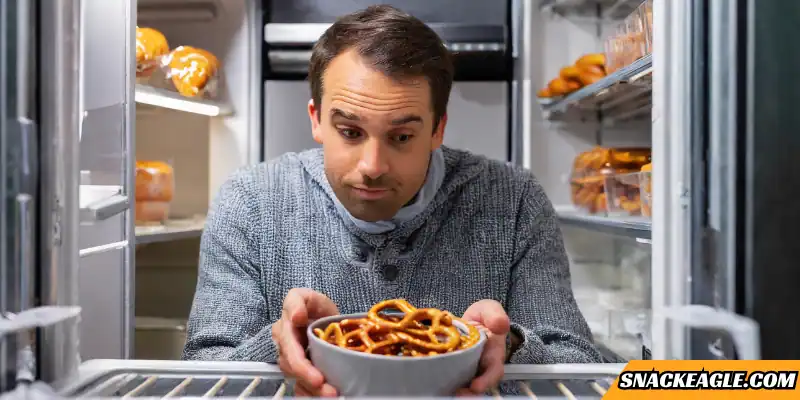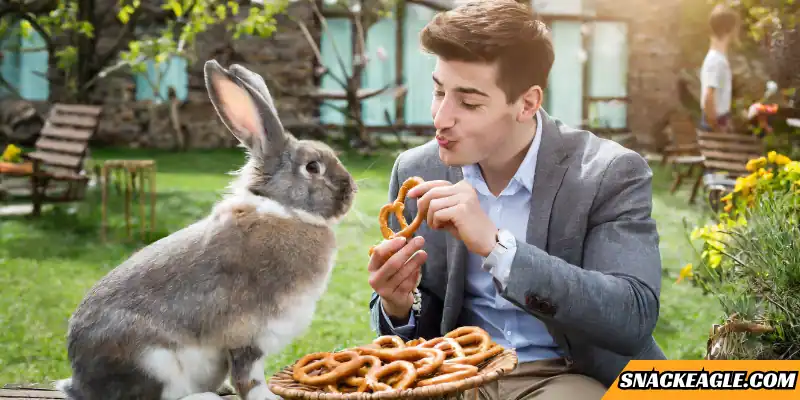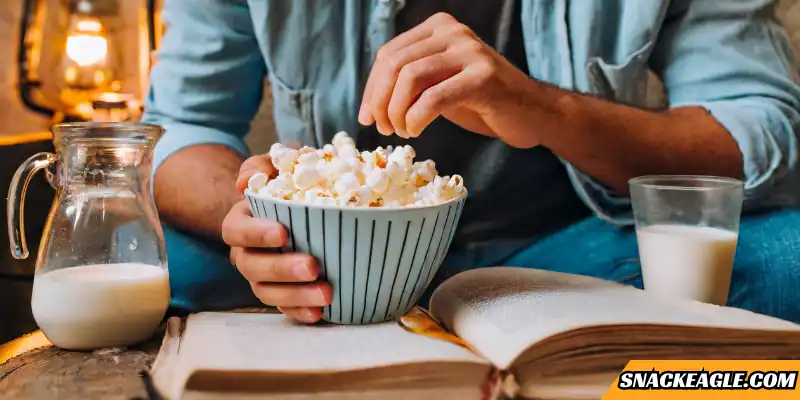Popcorn makes a delicious snack; the traditional way to make it is by microwaving the kernels in a store-bought bag. But can you boil popcorn? Absolutely!
Boiling is a preferred method if you crave unpopped popcorn with a soft outer shell. Plus, it avoids unedible, unpopped kernels at the bottom of the bag due to a lack of moisture inside of each kernel.
This method of cooking popcorn leads to a softer, tender texture with a longer cooking time. The boiling process heats each kernel on the bottom of the pan, which then rises and is kept away from direct heat to reduce burning.
Continue reading to explore how to boil popcorn and some general popcorn-making tips.
Can You Boil Popcorn? What Happens if you Boil Popcorn?
Yes. Boiling popcorn reduces the amount of pressure within the popcorn and leads to half-popped popcorn.
The excess moisture from the water also prevents any foam from forming. This creates a softer texture as opposed to a crunchy texture.
5-Step Guide On How To Boil Popcorn
Here’s how to make boiled popcorn:
Step 1
Boil the corn kernels: In a pot of boiling water, cook the corn kernels for approximately 30 minutes until tender.
Step 2
Drain and dry the boiled kernels: Once cooked, drain the water from the pot and transfer the boiled kernels to a kitchen paper or towel. Allow them to dry thoroughly in a cool place.
Step 3
Heat the pan and add oil: Place a pan on the stove and heat it up. Add a small amount of oil to the pan and let it heat.
Step 4
Test and pop the kernels: Drop a few kernels into the pan and wait for them to pop. This helps ensure that the oil is hot enough for popping the rest of the kernels.
Step 5
Pop the boiled kernels: Once the test kernels have popped, add the remaining boiled kernels to the pan and quickly cover it. Shake the pan occasionally to prevent burning. As soon as the popping slows down, remove the pan from the heat.
The Science Behind Boiled Popcorn
Will popcorn pop in boiling water? Yes, a kernel contains mainly starch with a small amount of water and has a strong outer shell called a pericarp. Once the temperature surrounding a kernel increases, the water inside heats up.
Once the water reaches boiling point, it turns to steam, which acquires more space than liquid. This steam causes the hard outer shell to soften but not pop, creating a fluffy consistency.
Tips on Boiling Popcorn
After boiling your popcorn, place the kernels in a popping bowl with a cover or a microwave-safe bag. Listen out for the popping sound, and remove them from the microwave as soon as it slows down. Otherwise, the kernels will burn.
Additionally, make sure that the water is already boiling before you drop in the popcorn. And check there’s enough liquid to fill every piece.
Can I Use an Oven Instead of Microwave for Popcorn?
Popcorn must be shaken vigorously throughout the heating process and kept in oil to increase the temperature rapidly for the desired crunch. As a result, oven popcorn doesn’t work the same as a microwave and won’t pop. Using an oven will just result in burnt popcorn kernels that haven’t popped.
Instead, stick to a microwave because they have the exact energy required for agitation (the process of increasing the temperature quickly).
Alternatively, you can use a stovetop to make homemade popcorn, and here’s how to do it:
Can I Pop Boiled Popcorn in an Air Fryer?
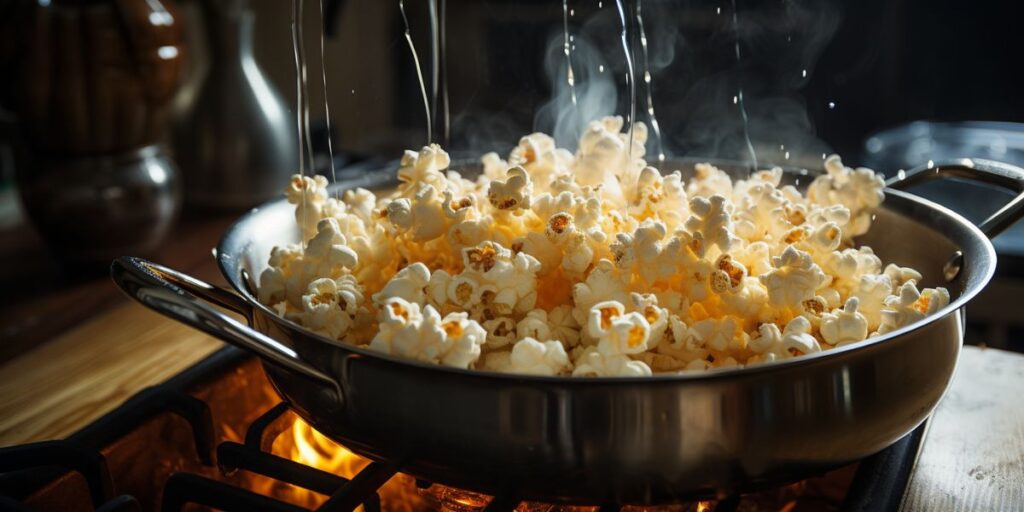
The good news is yes! Similar to an air popper, air fryers use hot air to heat food. These appliances also require a lot less oil than an oven without any chance of carcinogens in your popcorn that a microwave can produce.
Make sure to keep a close eye on your popcorn the first time you make it so you can get to know your cooker better as every model is different.
Only use one scarce layer as popped corn will quickly fill your basket and make it harder for the other kernels to get up to temperature if you put too much in.
If you like butter on your popcorn, you can melt this in a baking pan directly after pre-heat and before you pop your corn.
How to Fix Chewy Popcorn
If you’re trying to avoid chewy popcorn, boiling it might not be the best cooking method since all kernels won’t pop. However, here are some successful ways to prevent chewy popcorn and increase the crunch:
Don’t Let the Popcorn Sit For Too Long
Popcorn is delicious, so why would anyone not want to eat it right away anyway? But leaving it to sit for an hour or two after the kernels have popped means that the popcorn will absorb any humidity in the air. This leads to a chewy texture as well as a colder temperature.
Store Your Kernels with Care
One of the easiest ways to fix chewy popcorn is to store your kernels properly. Keep them in an airtight container, or, if they’re already open in a bag, seal them shut and transfer them to a tub.
Store the kernels in a dry and cool environment, such as in a kitchen cabinet. Avoid storing them in the fridge or freezer or anywhere too cold since this will increase the moisture levels in the air, preventing them from popping.
Cook Popcorn with the Lid Off
You can try cooking with the lid off for extra light and crispy popcorn. This way steam escapes more quickly and with a well-vented lid, leaves crispy popcorn for you to enjoy.
FAQs Boiling Popcorn
How do I make popcorn from boiled corn kernels?
To make popcorn from boiled corn kernels, start by boiling the kernels in water for approximately 30 minutes until tender. Drain and dry the boiled kernels, then heat a pan with oil on the stove. Test the heat by popping a few kernels, and once they pop, add the remaining boiled kernels to the pan, cover it, and shake occasionally until the popping slows down.
How does the boiling method work for cooking popcorn?
The boiling method involves placing popcorn kernels in a pot to soften the kernels first then cooking them in the usual way. This results in chewier popcorn.
What type of pot or pan is suitable for boiling popcorn?
It is recommended to use a pot or saucepan with a tight-fitting lid to trap the steam during the boiling process. Make sure the pot is large enough to accommodate the popped popcorn volume.
Why boil corn kernels before making popcorn?
Boiling the corn kernels helps soften them, making them easier to pop. This method is an alternative to using oil and can provide a healthier option for making popcorn.
What heat setting should I use when boiling popcorn?
Start by heating the pot over medium-high heat until the water reaches a boil. Once boiling, reduce the heat to medium-low to maintain a gentle simmer.
How long does it take to boil corn kernels for popcorn?
It usually takes around 30 minutes to boil corn kernels until they are tender enough for popping. However, cooking times may vary depending on the type and size of the kernels.
Can I add flavorings or toppings to boiled popcorn?
Yes, after transferring the popped popcorn to a bowl, you can add your desired flavorings and toppings such as salt, butter, cheese, or other seasonings. Shake the bowl gently to evenly coat the popcorn with the toppings.
Are there any specific precautions to take when making popcorn from boiled kernels?
It is important to be cautious when handling hot oil and closely monitor the popping process to prevent burning. Shake the pan occasionally to distribute heat and prevent kernels from sticking or scorching.
Boiling Popcorn Kernels💭
If you want to switch up how you make popcorn, try a different method: boiling the kernels. This process creates half-popped popcorn with a mixture of softer, chewy textures and tough kernels.
Happy popcorn-making!
If you want to switch up how you make popcorn, try a different method: boiling the kernels. This process creates half-popped popcorn with a mixture of softer, chewy textures and tough kernels.
Happy popcorn-making!

